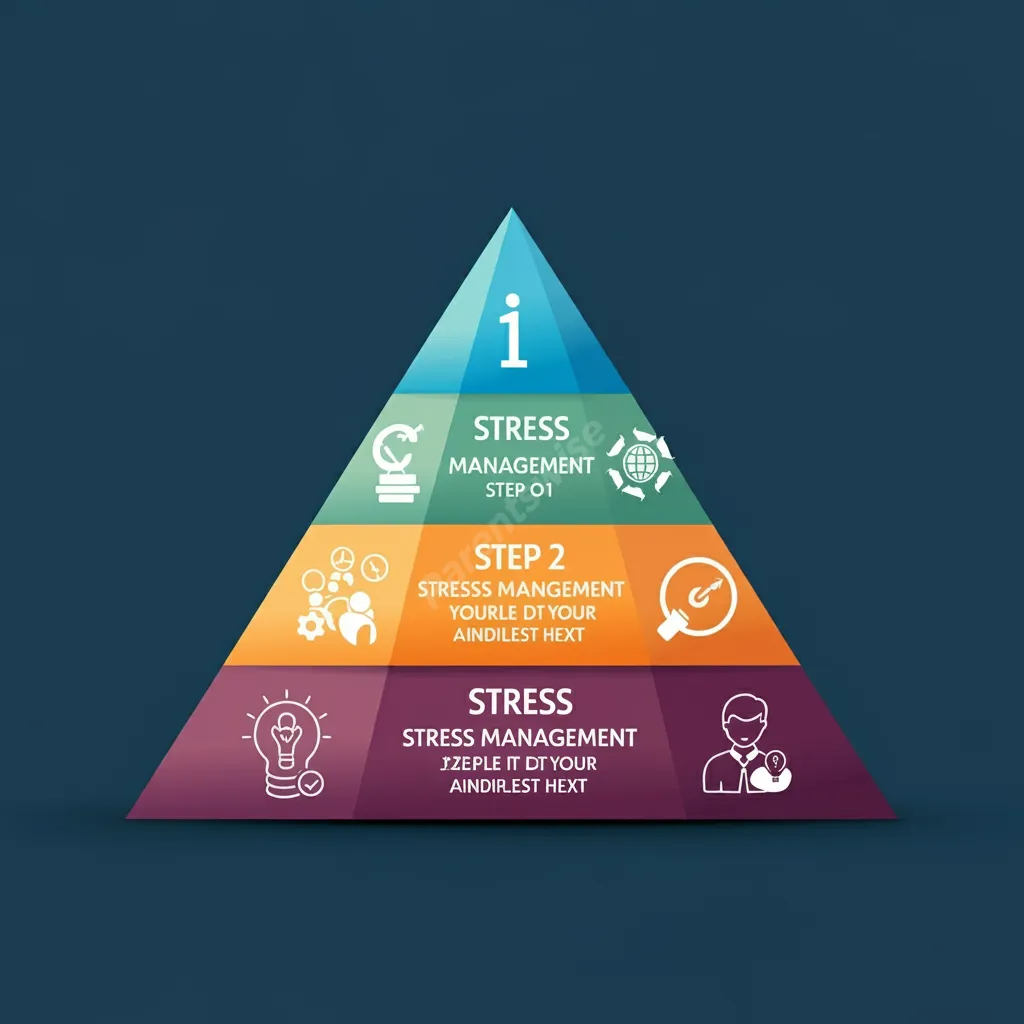Stress Management Pyramid: From Awareness to Action

Parenting is beautiful, but it’s also incredibly stressful. From sleepless nights with newborns to navigating teen years, parents face unique challenges. These challenges can leave even the calmest individuals feeling overwhelmed. But what if there was a better way to manage this stress? Let’s introduce the Stress Management Pyramid – a powerful tool for parents like you.
Imagine this common scenario:
- You’re racing to meet a work deadline
- Your toddler is having a meltdown
- Dinner is burning on the stove
Sound familiar? This is where the stress management pyramid comes in handy. It’s not just another parenting trick. The pyramid is a step-by-step approach to handle stress effectively. Here’s what makes it special:
- It helps you recognize your stress
- It guides you to assess your stress levels
- It provides strategies to actively manage stress
The best part? This pyramid is tailored for the chaotic yet beautiful life of a parent. By the end of this post, you’ll have a practical roadmap to transform stress into strength. You’ll be equipped to create a calmer home for both you and your children.
Understanding the Stress Management Pyramid

The Stress Management Pyramid is a visual tool to help parents tackle stress. It’s built on four key levels. Each level represents a crucial step in managing parental stress. Let’s break it down:
- Stress Awareness: The foundation of the pyramid
- Stress Assessment: Understanding your stress levels
- Building Support: Creating a network for help
- Action Strategies: Implementing stress-relief techniques
Think of this pyramid as your personal stress-busting guide. It starts with recognizing stress and ends with taking action. Each level builds on the one before it. This structure helps you address stress systematically.
Why is this approach particularly effective for parents?
- It’s step-by-step: Perfect for busy parents who need clear guidance
- It’s flexible: You can adapt it to your unique parenting situation
- It’s comprehensive: Covers all aspects of stress management
The pyramid approach acknowledges that stress management isn’t a one-size-fits-all solution. It allows you to focus on specific areas where you need the most help. As you climb the pyramid, you’ll gain more control over your stress.
Remember, managing stress is a journey. The pyramid gives you a clear path to follow. It helps you move from feeling overwhelmed to feeling empowered. In the following sections, we’ll explore each level in detail.
Level 1: Stress Awareness
The foundation of stress management is recognizing your stress. Many parents are so busy taking care of others that they overlook their own stress signals. Let’s explore how to become more aware of your stress.
A. Recognizing Your Stress Signals
Our bodies and minds have ways of telling us we’re stressed. Here are key areas to watch:
- Physical Signs:
- Tense muscles, especially in your neck and shoulders
- Headaches or migraines
- Changes in appetite (eating too much or too little)
- Difficulty sleeping or constant fatigue
- Emotional Indicators:
- Feeling irritable or short-tempered
- Experiencing anxiety or constant worry
- Mood swings or feeling overwhelmed
- Lack of motivation or enthusiasm
- Behavioral Changes:
- Procrastinating or neglecting responsibilities
- Withdrawing from social activities
- Increased use of alcohol, cigarettes, or caffeine
- Nervous habits like nail-biting or pacing

Being aware of these signs is crucial. It’s the first step in managing your stress effectively. Keep a simple journal to track these signals. This can help you identify patterns over time.
B. Common Parenting Stress Triggers
Understanding what triggers your stress is equally important. Here are some common stressors for parents:
- Daily Routine Challenges:
- Rushed mornings getting kids ready for school
- Hectic mealtimes with picky eaters
- Bedtime battles and interrupted sleep
- Work-Life Balance Issues:
- Juggling work deadlines with family commitments
- Guilt over not spending enough time with kids
- Financial pressures of raising a family
- Child-Related Stressors:
- Behavioral problems or tantrums
- Academic concerns or school-related issues
- Health worries or special needs care
Remember, every parent’s experience is unique. Your stress triggers might be different. The key is to identify what specifically causes stress in your parenting journey.
By becoming aware of your stress signals and triggers, you’re laying a solid foundation. This awareness will help you tackle stress more effectively in the next levels of the pyramid.
Level 2: Stress Assessment
Once you’re aware of your stress, the next step is to measure its impact. This level helps you understand how stress affects you and your family.
A. Measuring Your Stress Levels
Assessing your stress isn’t about judging yourself. It’s about gaining insights to manage it better. Here’s a simple way to measure your stress:
- Use a Stress Scale:
• Rate your stress from 1 (low) to 10 (high) daily
• Note what happened on high-stress days
• Look for patterns over a week or month - Track Your Triggers:
• Keep a list of events that raise your stress levels
• Note how often these triggers occur
• Identify which triggers have the biggest impact

Remember, consistency is key. Regular tracking helps you spot trends. You might notice certain days or situations consistently spike your stress levels.
B. Impact on Family Dynamics
Stress doesn’t just affect you. It ripples through your entire family. Let’s look at how:
Effects on Parent-Child Relationships:
- You might have less patience for your children’s needs
- Quality time with kids may decrease
- Your stress can make children anxious or act out
Influence on Partner Relationships:
- Communication may suffer when you’re stressed
- You might have less energy for your partner
- Teamwork in parenting can become strained
Impact on Overall Family Atmosphere:
- The home environment might feel tense more often
- Family routines could become disrupted
- Fun activities and laughter might decrease
Here’s a real-life example: Sarah, a working mom, noticed her stress peaking every Wednesday. She tracked it and realized it coincided with her busiest workday and her son’s soccer practice. This insight helped her rearrange her schedule for more balance.
Assessing your stress isn’t about feeling guilty. It’s about understanding your reality. This understanding is crucial for the next steps in your stress management journey.
Level 3: Building Your Support System
Managing stress isn’t a solo mission. Building a strong support system is crucial for parents. Let’s explore both internal and external support resources.
A. Internal Support Resources
Your internal resources are the tools within yourself to cope with stress. Here’s how to develop them:
- Personal Coping Mechanisms:
• Practice mindfulness or meditation daily
• Engage in a hobby you enjoy
• Use positive self-talk to reframe stressful situations - Self-Care Strategies:
• Prioritize sleep – aim for 7-8 hours nightly
• Exercise regularly, even if it’s just a 10-minute walk
• Maintain a balanced diet to fuel your body

Remember, self-care isn’t selfish. It’s necessary for being a good parent. Think of it as recharging your batteries to better care for your family.
B. External Support Network
Reaching out for help is a sign of strength, not weakness. Here’s how to build your external support:
Family and Friends:
- Ask trusted family members for help with childcare
- Schedule regular catch-ups with friends who uplift you
- Join local parenting groups for shared experiences
Professional Help:
- Consider talking to a therapist or counselor
- Consult your child’s pediatrician for parenting advice
- Seek financial advisors if money stress is an issue
Parent Support Groups:
- Look for online forums dedicated to parenting
- Attend local parent-teacher association meetings
- Join support groups specific to your situation (e.g., single parents, special needs parents)
Building your support system takes time. Start small. Reach out to one person this week. Share a concern or ask for help with a specific task.
A real-life example: Tom, a single dad, joined a local single parents’ group. He found not only practical tips but also emotional support. This network helped him feel less isolated in his parenting journey.
Remember, asking for help is brave. It shows you’re committed to being the best parent you can be.
Level 4: Action Strategies
Now that you’ve built awareness and support, it’s time to take action. This level focuses on practical techniques to manage your stress effectively.
A. Immediate Stress Relief Techniques
These are quick fixes for those moments when stress hits hard:
- Deep Breathing Exercise:
• Inhale slowly through your nose for 4 counts
• Hold your breath for 4 counts
• Exhale slowly through your mouth for 4 counts
• Repeat 5 times - 5-4-3-2-1 Grounding Technique:
• Name 5 things you can see
• 4 things you can touch
• 3 things you can hear
• 2 things you can smell
• 1 thing you can taste - Quick Physical Release:
• Do 10 jumping jacks
• Stretch your arms and legs
• Squeeze a stress ball

These techniques can help you regain control quickly. Practice them regularly so they become second nature.
B. Long-term Stress Management Plan
For lasting change, incorporate these strategies into your routine:
Daily Practices:
- Start your day with a 5-minute meditation
- Take short breaks throughout the day to stretch
- End your day by listing three things you’re grateful for
Weekly Routine:
- Schedule one hour of ‘me-time’ for a favorite activity
- Have a family meeting to address any brewing issues
- Plan and prep meals to reduce daily stress
Monthly Check-ins:
- Review your stress journal to identify patterns
- Adjust your routine based on what’s working
- Set new stress management goals
Remember, consistency is key. Small, regular actions often lead to significant changes over time.
Here’s a simple template to get you started:
| Time Frame | Action Item | Notes |
|---|---|---|
| Daily | 5-min meditation, gratitude journaling | Morning and evening |
| Weekly | 1-hour ‘me-time’, family meeting | Schedule in advance |
| Monthly | Review stress journal, set new goals | First weekend of every month |
Customize this plan to fit your lifestyle. The goal is to make stress management a natural part of your routine.
Making the Pyramid Work for You
The Stress Management Pyramid isn’t a one-size-fits-all solution. It’s a flexible framework that you can adapt to your unique situation.
A. Customizing the Approach
Every family is different. Here’s how to tailor the pyramid to your needs:
Adapting to Your Parenting Style:
- Authoritative parents might focus more on communication strategies
- Permissive parents could benefit from setting clearer boundaries
- Helicopter parents may need to practice letting go of control
Adjusting Based on Your Schedule:
- Working parents can integrate stress relief into their commute
- Stay-at-home parents might use naptime for self-care
- Single parents could involve kids in stress-relief activities
Remember, the goal is to make this work for you. Don’t be afraid to experiment with different strategies until you find what fits.
B. Common Challenges and Solutions
Even with the best intentions, you might face obstacles. Here are some common issues and how to tackle them:
- Challenge: “I don’t have time for stress management.”
Solution: Start small. Even 5 minutes a day can make a difference. Gradually increase as you see benefits. - Challenge: “I feel guilty taking time for myself.”
Solution: Reframe self-care as essential for good parenting. You can’t pour from an empty cup. - Challenge: “My partner doesn’t understand my stress.”
Solution: Share this pyramid with them. Make stress management a team effort. - Challenge: “I can’t stick to a routine with unpredictable kids.”
Solution: Be flexible. Have a few go-to strategies you can use anytime, anywhere.

Remember, progress, not perfection, is the goal. Every step you take towards managing your stress is a win for you and your family.
The Stress Management Pyramid offers a structured approach to handling parental stress. From awareness to action, each level builds on the last. Here’s a quick recap:
- Stress Awareness: Recognize your stress signals
- Stress Assessment: Understand your stress levels
- Building Support: Create your network
- Action Strategies: Implement stress-relief techniques
Remember, managing stress is a journey, not a destination. Be patient with yourself. Celebrate small victories. Every deep breath, every moment of self-care, is a step towards a calmer, happier you.
Your next step? Pick one strategy from this post and try it today. Maybe it’s tracking your stress levels or practicing a quick breathing exercise. Start small, but start now.
You’ve got this, parents. By managing your stress, you’re not just helping yourself – you’re creating a more peaceful, joyful home for your entire family.

